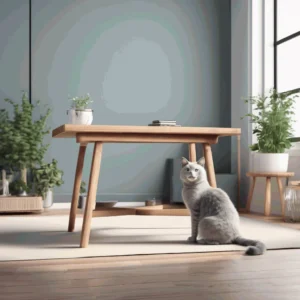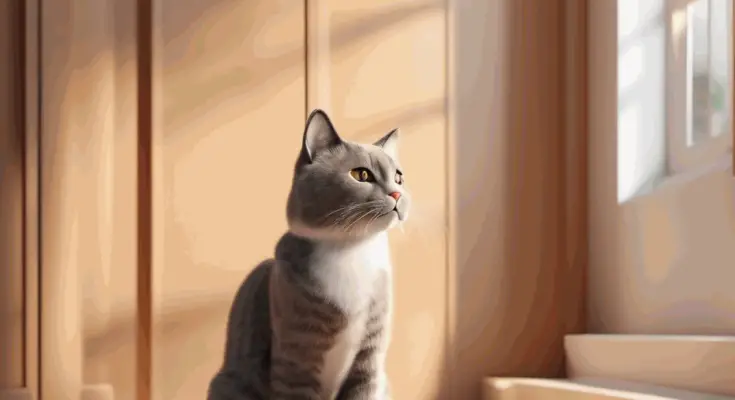Every cat owner has experienced the not-so-pleasurable surprise of finding their once flawless furniture now bearing unintentional ‘feline art’. Redirecting your cat’s scratching habits to a more appropriate surface is not only beneficial for your living room’s aesthetics but also for your furry friend’s well-being. Our guide on ‘how to train a cat to use a scratching post’ will be your stepping stone towards successful cat training techniques and improved feline manners around the house.
Key Takeaways
- Understanding your cat’s behaviors, such as scratching, is critical for successful training.
- Choosing the right scratching post, considering material and size, heavily impacts the success of the training.
- Positive reinforcement, like treats or catnip, is an effective tool for training a cat to use a scratching post.
- Patience and consistency are paramount when teaching new behaviors to pets.
- A deeper understanding of feline behavior can greatly benefit both you, as a pet owner, and your cat.
Understanding Why Cats Scratch
One of the fundamental steps in our cat scratching post-training guide involves understanding the core reasons behind your feline friend’s scratching behavior. This natural habit is deeply embedded in their instinctual needs which often include marking territory and maintaining healthy claws. Recognizing these essential drives can empower us to better train a cat to use a scratching post, bridging the link between our human desires and their feline instincts. Let’s delve further into the typical behaviors exhibited by cats and the benefits scratching brings to their health.

The Natural Instincts of Felines
Cats, being territorial creatures using nature, make use of scratching as a method of marking their area. This not only leaves a visible signal but also releases pheromones, signaling to different cats about their claim over a particular location. This scratching addiction is likewise a manner for our tom cat pals to maintain their claws wholesome and sharp, geared up for any looking or defensive possibilities that can come their way. Understanding these simple instincts is a fundamental part of effective feline behavior schooling.
Benefits of Scratching for Cat Health
Scratching behaviors serve as a crucial exercise for cats. It helps them to stretch their bodies, particularly their back and shoulder muscles, contributing to their overall physical health. It also provides a stress relieving outlet, akin to how we humans might use a stress ball. Helping your cat redirect this instinctual behavior towards a designated scratching post instead of your cherished furniture, can contribute to maintaining a peaceful cohabitation. Analyzing these benefits will arm you with the necessary knowledge to successfully train your cat, complementing their needs with your own.
| Instinct | Purpose | Benefit of Redirecting to Scratching Post |
| Scratching for territory marking | Releases visible and olfactory markers of a cat’s territorial claim | Prevents furniture damage and reduces household tension |
| Scratching for claw health | Keeps claws sharp and ready | Preserves home aesthetics and safety for home occupants |
| Scratching for physical exercise | Allows cats to stretch their back and shoulder muscles | Contributes to a healthy cat maintaining an active lifestyle |
| Scratching for stress relief | Provides an outlet for pent-up energy or stress | Promotes a relaxed, content, and well-behaved feline |
Choosing the Right Scratching Post
One of the fundamental cat training tips in how to teach a cat to use a scratching post is to select the right post. An appropriate scratching post is an essential part of the training process and significantly influences the success of its usage. Varieties in material, size, and stability cater to the individual preferences of different cats.
In your quest for the perfect scratching post, take into account a few key factors:
- Material: Cats are instinctively drawn to certain textures for scratching. Posts encompass different materials like sisal rope, cardboard, and carpet. You might need to experiment a bit before deciding which material your furry friend prefers.
- Size: The post should be tall enough for your cat to stretch out vertically. Cats love a full vertical stretch after a good nap. Ensure the post is high enough to allow this. A rule of thumb is to have the post 1.5 times your cat’s length when fully stretched.
- Stability: Cats avoid unstable posts that could potentially tip over when they’re scratching or climbing. A steady, durable base is crucial for a scratching post.
For those exploring DIY cat scratching post-training, using materials that your cat is already attracted to can be a head-start in the right direction. Remember, it’s all about learning what your cat likes and catering to those preferences.
| Material | Recommended For |
| Sisal Rope | Cats who prefer a rough texture |
| Cardboard | Cats who enjoy shredding soft surfaces |
| Carpet | Cats who love to sink their claws into thicker materials |
Train a Cat to Use a Scratching Post
It’s time to dive into the delightful challenge of cat training, turning your feline friend from an upholstered furniture scratcher into an ardent scratching post user. With the right approach, practice, patience, and a sprinkle of positive reinforcement, it’s possible to train a cat to use a scratching post. Let’s get into the detailed mechanics of this journey.
Introducing Your Cat to the Scratching Post
Your cat’s introduction to the scratching post must be gradual yet enticing. A widely accepted method is to guide your cat’s paws towards the post, mimicking the scratching action. However, avoid forcing them as it may lead to fear and negativity associated with the post. Let’s look at this process more in-depth in the following table.
| Steps | Description |
| Location Selection | Choose a quiet but commonly accessed area by the cat, away from their litter box. |
| Mimic The Action | While your cat observes, scratch the post with your own hands. This makes them curious and triggers their interest. |
| Guidance | Softly guide your cat’s paws to the post, showing them how to scratch. However, ensure the cat is relaxed and do not force them. |
| Observation | Monitor your cat’s interaction with the post. If they respond positively, add more posts to increase engagement. |
Remember, each cat’s response can differ, hence patience is key in this process.

Using Catnip and Treats as Positive Reinforcement
Positive reinforcement is a proven and effective way of training a cat. In the context of the scratching post, the reinforcement can come in the form of catnip or favorite treats. This makes the scratching post attractive and invites the cat to associate it with positive rewards and experiences.
“Cats love consistency. They want to know what to expect, and they want to trust that their expectations will be met”
By regularly offering treats every time they use the scratching post or spraying the post with a little catnip, you are constructing a positive environment for your cat to willingly participate in the training.
The following process outlines using positive reinforcement for training your cat to use the scratching post:
- Apply catnip or a treat to the scratching post.
- Once your cat scratches the post, reward them with their favorite treat or petting.
- Repeat the process consistently, establishing a pattern and association.
With time, your cat will associate the scratching post with rewards and form a habit of using it. Maintaining regularity in offering reinforcements and keeping the training sessions enjoyable is crucial to ensure successful adaptation to the scratching post.
Cat Training Tips for Success
Delving beyond the fundamental strategies, offering nuanced advice on the varying training methods for cat behavior forms the crux of this section. The premise of successful cat training techniques nests on a harmonious blend of knowledge, technique, and patience. Let’s delve in to discover how we can help our feline companions learn most effectively.
Patience: The Key to Success
As any experienced cat trainer will affirm, patience isn’t just a virtue in cat training; rather, it is a necessity. Just like humans, cats too have their unique pace of learning and their pace must be respected. Never resort to negative reinforcement or punishment; it simply doesn’t work with cats. Instead, fortify your patience and employ positive reinforcement for effective training.
Consistency is Key
Consistency in command words, gestures, and rewards aids in creating a clear line of communication between you and your cat. Inconsistent commands can confuse your feline and hinder the training process.
Utilize Positive Reinforcement
Rewards such as playtime, affection, treats, or praise can work wonders in reinforcing desired behaviors in cats. Remember, the reward should be instant, ideally within two seconds of the desired behavior, to ensure the cat associates the reward with the action.
Take Breaks
Short training sessions are more effective, as cats can easily lose interest or become distracted. It’s best to keep training sessions to about 10-15 minutes each.
Consider Your Cat’s Perspective
Understand your cat’s needs and motivations – this will not only help in training but in building a stronger bond with your feline companion too.
Understanding cat behavior and applying these cat training tips can lead to a successful training experience for both you and your cat. End each session on a positive note, ensuring your cat associates the training with a pleasant experience.
| Tips for Successful Cat Training | Description | Why it Works |
| Set realistic goals | Start with simple commands and gradually progress. | Avoids overwhelming the cat and keeps training focused. |
| Consistency | Consistent command words and gestures | Avoids confusion and enables better understanding for the cat. |
| Positive Reinforcement | Instant rewards for desired behavior | Encourages repetition of the desired behavior. |
| Take Breaks | Short, frequent training sessions | Keeps the cat engaged and avoids fatigue. |
| Understand Your Cat | Consider your cat’s needs and motivations | Builds trust and facilitates effective communication. |
Positive Reinforcement for Cats
In this concluding phase of our manual on a way to educate a cat to apply a scratching post, we emphasize the centrality of high-quality reinforcement for cats in coaching favored behaviors. A correctly educated cat now not only protects your fixtures from destruction but also helps to construct a more potent bond between you and your feline companion. The exceptional approach to achieving this lies in understanding unique forms of reinforcements and effective techniques for their software.
Understanding Positive vs. Negative Reinforcement
While each effective and bad reinforcement can affect conduct, they do so in one-of-a-kind methods. Positive reinforcement involves profitable the cat for showing the preferred conduct, encouraging them to repeat it. In evaluation, poor reinforcement eliminates an undesirable stimulus while the desired behavior is exhibited. In the context of DIY cat scratching post-training, fantastic reinforcement is more effective and beneficial for the cat’s well-being, instilling behaviors that stick without causing misery or fear.

Examples of Positive Reinforcement Techniques
Examples of tremendous reinforcement techniques used in feline conduct schooling consist of profitable the cat with a treat, praise, or a favorite toy after they use the scratching post. Consistency is key in this method; make certain the praise is given without delay after the preferred conduct, increasing the chance of the cat linking the motion with the praise. With repeated practice and consistent rewards, your cat will certainly gravitate towards using the scratching post as opposed to your loved one furniture.
We hope this manual empowers you in your adventure to schooling train a cat to use a scratching post publish. Remember, persistence and consistency blended with advantageous reinforcement form the muse of a hit education enjoy, main to a satisfied tom cat and a glad you!
FAQs
[sp_easyaccordion id=”361″]



